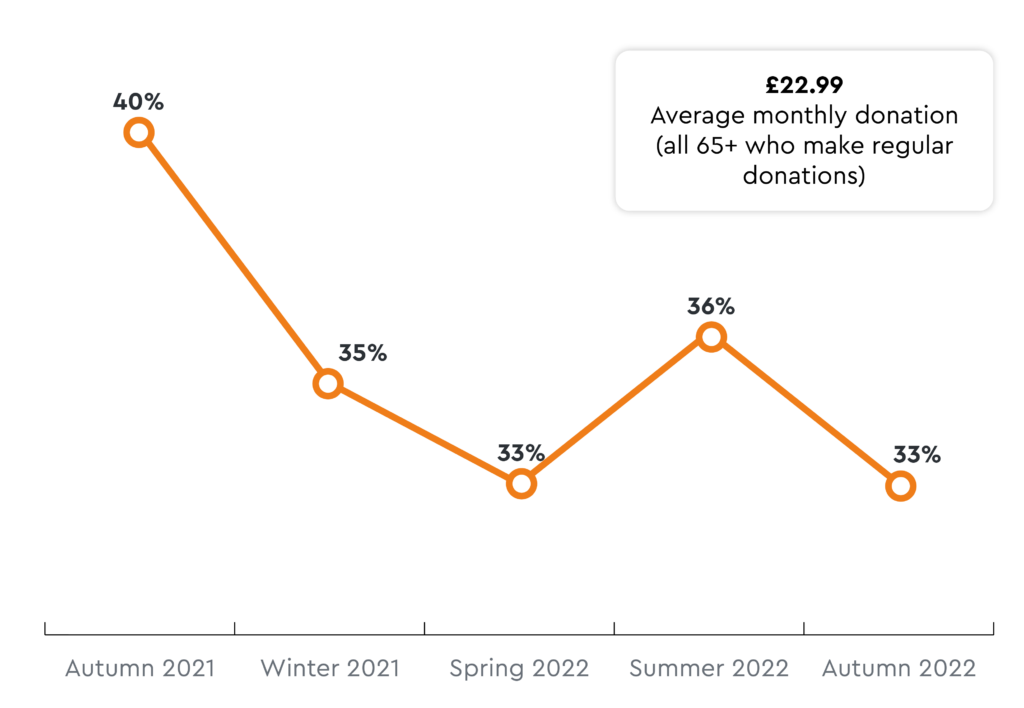
In the newest edition of our quarterly Donor Pulse report, the research looks at the impact of the cost of living crisis on donations and fundraising as well as the state of play for workplace fundraising. We hope the research provides your charity with actionable insights for your fundraising campaigns.
The cost of giving
The research shows that 63% of people are feeling worse off than six months ago, an increase of five percentage points since the last report and a jump of 17 percentage points from Spring 2022. The increase in the price of groceries, fuel and energy is impacting the public’s ability to donate and is creating a ‘cost of giving’ crisis, with 61% of the public stating that their financial situation makes it harder to donate.
This has resulted in a quarter of those people feeling worse off expecting to make fewer donations while 17% expect to make smaller donations. The average figure is improved by Gen Z, where 58% actually feel better off or the same. All other age groups have at least 60% feeling worse off with 40-64 year olds having the most difficult time. The 55-64 age group has the most people feeling worse off at 73%.
When it comes to the reasons why people are feeling worse off, energy (81%) and food prices (67%) continue to dominate. Further down the list a quarter of people are concerned about the prospect of recession and one in five (22%) are worried about their rent and mortgage costs.

Donations are weathering the storm
The good news for charities is that, despite the economic pressures, 75% of the public have donated in the past three months. This has been bolstered by under 40s with 79% having donated. Furthermore, 71% of people say they intend to give again in the next three months. Generosity remains strong across different income levels with 82% of households earning £40,000 or more having donated to charity in the last quarter. This number stays at 64% for households earning £20,000 or less
There is however a varied picture when it comes to regular donations. Of those surveyed, 5% said they plan on cancelling them, 8% decreasing them and 15% increasing them. One challenge for charities will come from the decrease in over 65s who make regular donations. This has dropped from 40% to 33% in the last year and is concerning as the average donation amount of this group tends to be higher. The average monthly donation for regular giving across all age groups is £17.32 versus £22.99 from those over 65.

44% of people have given online in the past three months and many have been motivated by a sense of moral duty. Two in five (39%) people said this was a key reason why they gave, followed by 27% saying the charity helped someone close to them and 24% saying they wanted to help others get a basic standard of living. Just 13% said they were inspired by posts on social media but this figure was far higher for Gen Z (27%) and millennials (20%).
“It has been a stormy period for the economy with increasing interest rates bringing new challenges to charity supporters, alongside inflation driving the rising cost of energy and food. Despite this, donations have remained high, and although this will not be an easy winter the public remain steadfast in their intention to donate in the coming months, compelled by a sense of moral duty and a need to help people with the cost of living.”
“And many of those donations will be given at work. Nearly half of employees have taken part in a workplace charity event in the last few months. This is despite hybrid working being the norm for many – people have not returned to 2019 ways yet. For charities to make the most of this opportunity it’s important that campaigns are flexible enough to cater for this.”
Chester Mojay-Sinclare, CEO and Founder, Enthuse
Workplace fundraising
Fundraising at work is an important source of revenue for charities but things have yet to return to pre-pandemic levels. Half (49%) of workers say they have taken part in a charity event in the past three months. Gen Z is the most actively involved with 70% taking part in a workplace charity event, followed by 58% of millennials and 40% of Gen X. While this makes for positive reading for the third sector, it’s worth noting that just two in five people are at their workplaces five days a week, with nearly half (47%) spending three days or less there.

When it comes to the split in working locations, 53% say they are based in work premises with a further 20% saying they are hybrid or flexible. 16% say they are home based and 10% are mostly mobile workers. Mobile employees are the most likely to get involved in fundraising events (61%) with home based workers the least likely (30%). Office based (51%) and hybrid (49%) are broadly similar in their participation levels.









